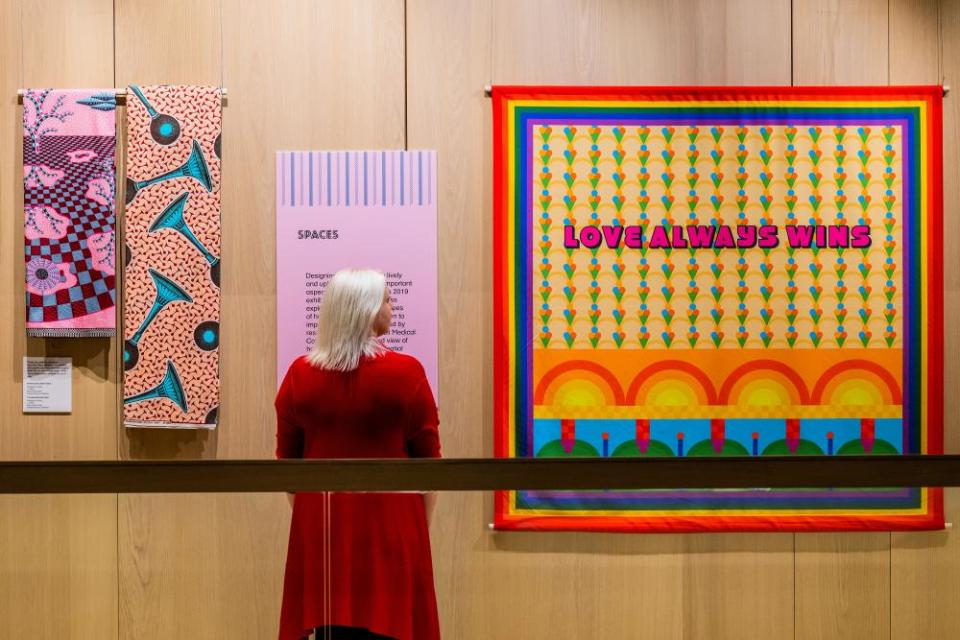Yinka Ilori: Parables for Happiness review – the brighter the better
With Yinka Ilori, what you see is what you get. The designer, born in London in 1987, regularly says that he wants to draw on his Nigerian roots to “bring together communities” and “evoke a sense of joy and optimism”. Which he then does, with a palette of colour clashes that shouldn’t work but do – hot pink-orange-maroon-green, for example, or mauve-red-yellow-turquoise – plus childlike geometries of circles and oblongs, and a penchant for improvisation. The results can be seen in a basketball court in Canary Wharf, or on cushion covers, or on objects and installations for brands such as Pepsi, Meta and LG, or on morale-boosting billboards put up during the pandemic.
It could all be a bit glib – a case of giving his clients in corporations or government agencies what they want by way of diversity boxes ticked. When Courvoisier announce Ilori as their “exclusive Ambassador of Joy”, it was hard not be a little sceptical. Except that, as his new installation at the Design Museum shows, the work is evidently heartfelt. Called Parables for Happiness, it shows Ilori’s inspirations and collaborations as much as his own work; so you see fabrics sold in market stalls in Lagos; the covers of 1970s Nigerian LPs; editions of the music magazine Drum. There is the never-to-be-built utopian architecture dreamed up by the late Congolese artist Bodys Isek Kingelez, here represented by a cardboard and plastic model of a tower, green yellow and blue, an African baroque composition of cylinders and concavities, fat and thin, and round and sharp.
The show, curated by the museum’s head of curatorial, Priya Khanchandani, also includes classics of furniture design such as the angular and abstract Red Blue Chair designed by the Dutch modernist Gerrit Rietveld more than a century ago. There are chairs by Jane Atfield, a pioneer in designing with recycled materials who taught Ilori at London Metropolitan University, and by his friend and mentor David Adjaye. There is the bright red LM Stool by the Nigerian designer Nifemi Marcus-Bello, made of the sheet metal used to make electrical generators.
The works of the famous and the anonymous, African and European, living and dead, across media and disciplines, are brought together without discrimination or hierarchy. They collectively and individually communicate a kind of fearlessness. The Lagos fabrics, which mix up traditional patterns with motifs of spark plugs and electric fans, display an inspired unconcern with ordinary ideas of congruity or taste that pervades the whole installation.

A guiding idea is that of play. Ilori’s own projects include a Flamingo-themed playground on the century-old Becontree estate on the outer edge of London and a Lego-sponsored “reimagining” of a launderette as a play zone, both represented by videos of the designer working with the children who will use the spaces. There’s a snap of the playground on the Marquess estate in Islington, where he grew up – a place celebrated by architects for the intimate scale of its courtyards and small blocks, but which still suffered from crime and vandalism. A caption explains the importance of the playground to the young Ilori. “You would think all the objects were made out of gold,” he says.
This playground (not designed by Ilori) features some modest structures in orange and blue, standing out against the dark brick of the estate, that establish a motif of colour against a neutral backdrop – the ubiquitous earth tone of London walls – that might be said to be a defining one of Ilori’s career. One of his most powerful works was the temporary Colour Palace (2019) that he and the architects Pricegore designed outside Sir John Soane’s beige-ish Dulwich Picture Gallery. “It would be better off in a Lagos shanty town”, emailed an outraged MP.
Ilori’s challenge to what might be called Establishment Brown continues in the Design Museum, here with the oak panelling installed when the museum was formed out of the old Commonwealth Institute to the designs of John Pawson in 2016. In truth, for all the energy of its exhibits, Ilori’s installation doesn’t entirely escape the minimalist straitjacket of its setting. As a free display, it hasn’t come with the sort of budget that would help it do so.
It’s a bit wall-bound, edging around the narrow balconies of the museum’s atrium, when it might have been more compelling to build a three-dimensional version of Ilori’s studio, or hang his big posters in the void. But it still shows how far a designer like him can go with a simple premise: to use colour and play and boldness to bring collective enjoyment to the shared spaces of a city.
Yinka Ilori: Parables for Happiness is at the Design Museum, London, until 25 June 2023

 Yahoo Movies
Yahoo Movies 
